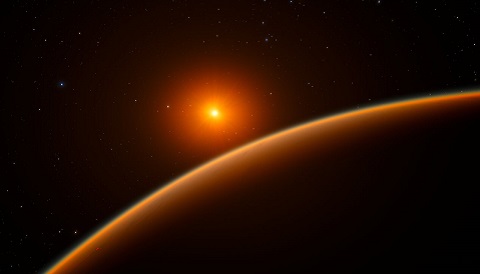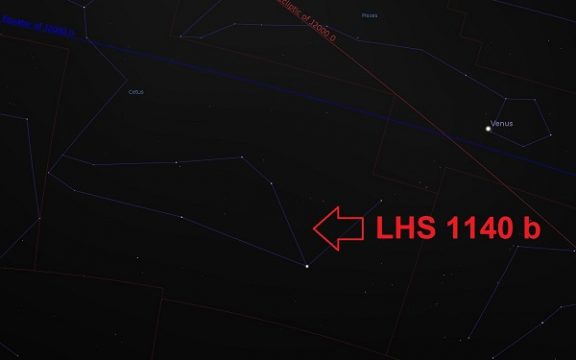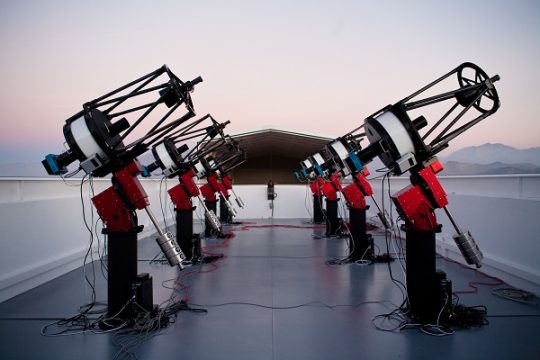The MEarth exoplanet survey has nabbed a rocky super-Earth transiting its host star just 41 light-years away from Earth.

ESO/SpaceEngine.org
We're getting our first good characterizations of terrestrial exoplanets lately. First, news broke of a possible planet around the nearest star to our Sun, Proxima Centauri. Then, we explored TRAPPIST-1, a mini solar system just 39 light-years away. Now, researchers from the Harvard-Smithsonian Center for Astrophysics announced the discovery today of a possible super-Earth orbiting an M-dwarf star just 41 light-years away. The discovery was published in the April 20th Nature.
LHS 1140b is a tantalizing find. Its cool, red host, LHS 1140, contains only 15% the mass of our Sun and is at least 5 billion years old. The planet passes in front of its star once every 25 days as seen from Earth. Jason Dittmann (Harvard-Smithsonian Center for Astrophysics) and team combined discovery data from the MEarth project with radial-velocity measurements from the High Accuracy Radial velocity Planet Searcher (HARPS) survey.
The high-resolution followup observations enabled researchers to calculate the planet's orbital parameters and physical characteristics to a high degree of precision: The super-Earth, containing between 4.8 and 8.5 times Earth's mass, orbits just 0.09 astronomical units from its primary (almost a quarter of the average distance between the Sun and Mercury). The planet spans around 1.4 Earths. Combine its mass and radius and you'll calculate an incredibly dense planet between 9.1 and 15.9 g/cm3 — more than twice Earth's average density!
Though red dwarfs are often tempestuous flare stars — a strike against life on any orbiting worlds — they're also long-lived and miserly in terms of energy output. These cool stars are expected to shine for trillions of years, longer than the present age of the Universe. That's a plus in that it gives ample time to get the engine of evolution going.
And LHS 1140 may prove to be special compared to the TRAPPIST-1 system, which also features a red dwarf star, Dittmann argues. TRAPPIST-1 rotates quickly, about once every three days, and that rotation powers stellar activity at high-energy wavelengths, which can dessicate planets and wipe out life. LHS 1140, on the other hand, appears to be inactive. "We don't see any flares in our years of monitoring it," Dittmann says. That's perhaps unsurprising, given the star's rotation period of 130 days. While red dwarf stars have long been maligned for their inhospitability, placid LHS 1140 may prove to be the exception to the rule.
The 14th-magnitude star is located near right ascension 00h 45m, declination -15° 14′, in the constellation Cetus the Whale.

Stellarium
Scanning Red Dwarfs for Rocky Worlds
The MEarth Project (pronounced “mirth,”) is designed to hunt for Earth-sized planets around nearby M-dwarf stars (the “M” in “MEarth”). Launched in 2014, the MEarth exoplanet survey consists of two arrays of eight 16-inch telescopes (each about the size of a large amateur telescope). One group is located in the Southern Hemisphere, at the Cerro Tolodo Inter-American Observatory in Chile, and the other at the Fred Lawrence Whipple Observatory south of Tucson, Arizona. The MEarth project uses these groundbased observations to look for exoplanets transiting nearby M stars, noted by the telltale dips in brightness when the planet passes in front of its host star. To date, MEarth has discovered three exoplanets (the other two were GJ 1214b and GJ 1132b).

Johnathan Irwin
All three MEarth planets are super-Earths. But just what a super-Earth looks like up close is still a matter of conjecture. In our own solar system, Earth dominates the terrestrial worlds; the distant ice giants, Uranus and Neptune, are the next up in size. But planets between Earth and Neptune in size appear to rule the galaxy. Researchers are still ferreting out whether these planets are rocky like Earth or gaseous like Neptune on a case-by-case basis.
LHS 1140b receives about half as much of its sun's energy as Earth does from our Sun. So while it's certainly massive enough to retain an atmosphere, and possibly even liquid water on its surface, any claims of "Earth-like" (versus the simpler "Earth-sized") come with the ready caveat: terrestrial planets appear to come in more types than we yet realize. From a distance, even Venus appears "Earth-like," but I wouldn't bet on an interstellar ark headed there.
Still, nearby worlds such as LHS 1140b make great potential targets for future missions such as the James Webb Space Telescope (JWST) and the Transiting Exoplanet Survey Satellite (TESS), both of which launch next year.
Next up: obtain a spectrum of LHS 1140b and see what sort of atmosphere it has — and if its atmosphere contains signatures of biological activity.
"LHS 1140b is the best terrestrial exoplanet for follow-up studies," says Elisabeth Newton (MIT). "Proxima b doesn't transit its host star, which means that we can't use JWST to study its atmosphere. The TRAPPIST-1 star is a much fainter star, which means that measuring the mass of the planets through radial velocities is extremely challenging."
We're getting to know our own exoplanet neighborhood, and brave new worlds such as LHS 1140b, a little at a time.
 7
7
Comments
John
April 21, 2017 at 5:28 pm
The purported density seems a bit out of line - other than a huge iron core comprising relatively more of the planet than those in our local neighborhood, how would you explain such a high density?
You must be logged in to post a comment.
David DickinsonPost Author
April 21, 2017 at 6:08 pm
Hi John,
I haven't as of yet seen any theories as to just how such "Super-Earths" came to be; there's no real analogue for these types of planets in our own solar system.
-Thanks,
Dave Dickinson
You must be logged in to post a comment.
Monica Young
April 24, 2017 at 3:48 pm
Hi John (and Gordon below): You're right that the density is surprisingly high. I was going to reply by simply saying that there's a large range of uncertainty in the density (and I've clarified this in the text). But, while that's true, I figured I might as well ask the lead scientist on this discovery, Jason Dittmann. He responded with a couple interesting points: first, the density is *possible* if you make a planet entirely of iron - the density would increase as the iron is crushed under the planet's own weight. However, that scenario isn't particularly *plausible* given what we know about planet formation. Dittmann adds that the radius is very well known, while the mass measurement has more uncertainty to it - future measurements (and they have an observing campaign coming up) may well bring that mass measurement down. Until then, though, the density will remain a bit of a mystery!
You must be logged in to post a comment.
David DickinsonPost Author
April 24, 2017 at 5:03 pm
A response from Jason Dittmann earlier today:
“Indeed, we have found a *very* high density for our planet, and there's a lot to unpack in this.
We believe our radius measurement to be robust, and so this high density is principally the result of our mass measurement. So, first of all, doing this mass measurement is already a very time consuming and tricky process, and in our paper we discuss some of the gritty details that we think may be affecting our result.
I'll preface the next few things I'm about to say about our mass measurement by nothing that the error bars on our current mass measurement are not able to exclude a composition like the Earth (30% iron core surrounded by a silicate mantle), so there might already be reason to believe that with additional data we will slide back towards this value. However, our current "best fit" central value is higher.
There are several reasons why this might be the case. We know that stars are able to create their own radial-velocity signals through stellar activity (in short, starspots and other features on the surface of the star have their own radial velocity signal). Our measurements were taken over a long period of time, during which these features on the surface were likely changing. We are unable to correct for this effect perfectly, and so it's perfectly reasonable to think that RV-effects from the star itself may bias our mass determination towards higher masses. To be more quantitative about this, if we take our radial velocities and phase-fold them to the rotation period of the star, we can see variation from the star that's the same size as the effect due to the orbit of the planet! So, this effect may be quite important actually.
A more fun reason why our current radial velocity mass measurements may be biased is that there may be additional planets in the system, possibly close to mean-motion resonances (so at exactly 1/2 or 1/3 or 1/4 or something of the orbital period of the planet). We don't have enough data right now to disentangle the effect of additional planets causing the star to wobble, so this effect may actually be "incorporated" into the radial velocity measurement of the one planet we have detected currently. Particularly, if planets are in mean motion resonances, this may bias our result towards higher masses.
At the moment we don't really know. But you're absolutely correct that LHS 1140b right now seems to be a very big, hefty planet. I believe more data will ultimately bring that mass down, because the composition that we would need to explain it's high mass right now (almost entirely iron, crushed to higher density by its own weight), doesn't seem physically plausible given what we know about planet formation.
To address this point, we're hoping in this coming year to really hammer this system with radial velocities (observations almost every single night for 2 months). This will allow to hopefully detect any additional planets and also not give the features on the star's surface time to change appreciably and bias our results.”
I think the take away is we're uncertain how dense LHS 1140 b is exactly until more observations are carried out, but its almost certainly more than Earth's. I wonder where rocky planets "max out"?
Thanks,
Dave Dickinson
You must be logged in to post a comment.
Lindsay
April 21, 2017 at 11:23 pm
John is right. And, I wonder about the temperature of the planet. Would it have a conductive liquid layer that generates a magnetic field?
You must be logged in to post a comment.
Bob
April 22, 2017 at 1:54 pm
I liked the artist trip to LHS 1140b.
Thank you.
Bob
You must be logged in to post a comment.
Gordon-Strader
April 24, 2017 at 3:18 am
The density listed is very improbable. Lead has a density of 11.34 g/cm3 and this planet is even denser on average? It's hard to imagine that atoms heavier than lead would constitute the majority of available material in a planet forming disk.
You must be logged in to post a comment.
You must be logged in to post a comment.